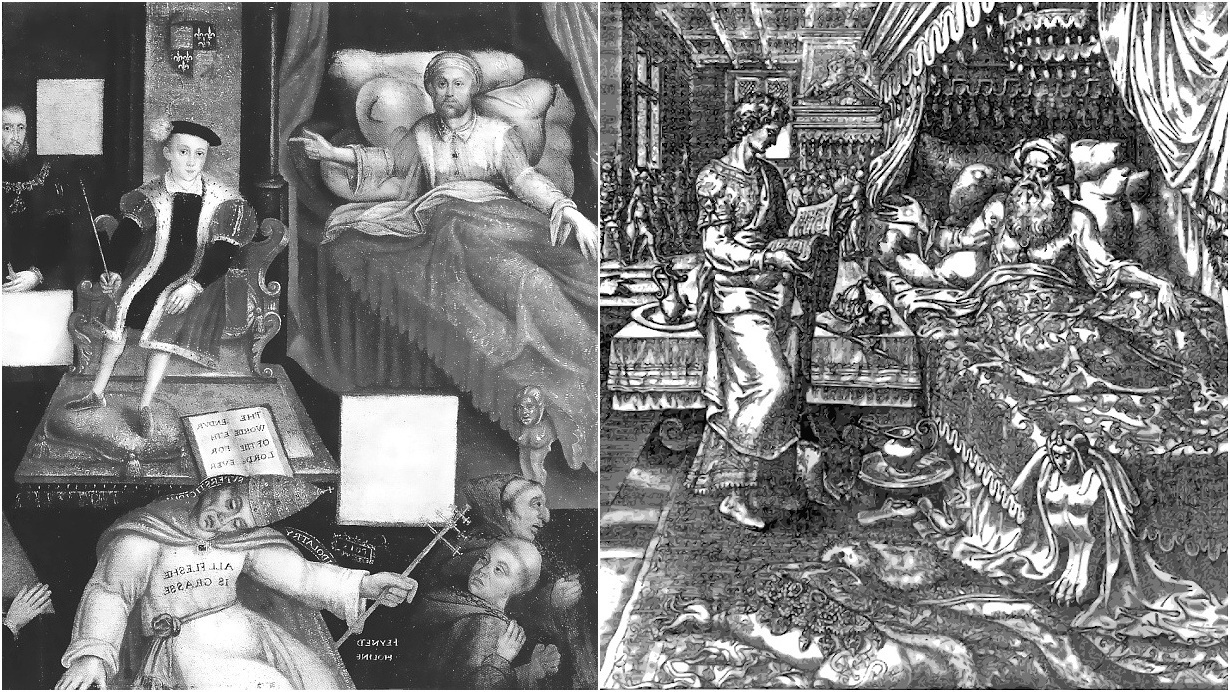This is a comparison of four works of art (the first of them is shown together with the preparatory draft). Each of them perhaps is unusual in itself. But what connects them is fascinating as well (at least to me). This side-by-side assembly is the result of a kind of collaboration between Henry Holiday, J. E. Millais, an anonymous painter and Philip Galle (with an engraving reproducing Maarten van Heemskerck’ work). In each segment (shown here) of an artwork the younger artists alludes to the work of the older artist. Is this pictorial citation chain an insider game between artists? How about discussing that in the classroom?
- [1, left] – 1876, Henry Holiday (engraver: Joseph Swain): The illustration detail on the very left side is a vectorized scan from Holiday’s illustration to an 1910 edition of Lewis Carroll’s The Hunting of the Snark.
- [1, right] – Additionally you see a segment from Holiday’s preperatory draft. You clearly can see how Henry Holiday intended to give parts of the drapery the shape of breasts.
- [2] – 1850, the young John the Baptist in John Everett Millais‘ Christ in the House of His Parents (aka The Carpenter’s Shop). The left leg of the boy looks a bit deformed. This is no mistake. Probably Millais referred to #3 and to #4.
- [3] – Henry VIII’s bedpost, 16th century, anonymous: Detail (in mirror view) from Edward VI and the Pope, an Allegory of Reformation. The pope could be Paul III.
- [4] – (bedpost #3 alludes to bedpost #4): 1564, Redrawn segment of a print Ahasuerus consulting the records by Philip Galle after Maarten van Heemskerck. The resemblance of #4 to the image #3 (the bedpost) was shown by the late Margaret Aston in 1994 in The King’s Bedpost: Reformation and Iconography in a Tudor Group Portrait (p. 68). She also compared the bedpost to Heemskerck’s Esther Crowned by Ahasuerus.
All segments shown in the image at the top of this page are details from the lower right corners (see yellow marker frame) of the four images (paitings and prints shown below) from which these details were taken:

- [left]: Henry Holiday: Depiction (1876) of the Baker’s visit to his uncle in Lewis Carroll’s The Hunting of the Snark (engraved by Joseph Swain). Outside of the window-like inset are some of the Baker’s 42 boxes.
- [right top]: John Everett Millais: Christ in the House of His Parents aka The Carpenter’s Shop (1850).
Location: Tate Britain (N03584), London.
Literature:
(1) Deborah Mary Kerr (1986): John Everett Millais’ Christ in the house of his parents (http://circle.ubc.ca/handle/2429/26546)
(2) P. 34, Éva Péteri (2003): Victorian Approaches to Religion as Reflected in the Art of the Pre-Raphaelites, Budapest 2003. ISBN 978-9630580380
(3) Albert Boime (2008): Art in an Age of Civil Struggle, 1848-1871
p. 225-364: The Pre-Raphaelites and the 1848 Revolution, ISBN 978-0-226-06328-7 - [right middle]: Anonymous: Edward VI and the Pope, An Allegory of Reformation, mirrored view (16th century, NPG 4165). Iconoclasm depicted in the window-like inset. Among the persons under that inset, 3rd from left is Thomas Cranmer who wrote the 42 Articles in 1552.
Edward VI and the Pope (NPG 4165) was, until 1874, the property of Thomas Green, Esq., of Ipswich and Upper Wimpole Street, a collection ‘Formed by himself and his Family during the last Century and early Part of the present Century’ (Roy C. Strong: Tudor and Jacobean Portraits, 1969, p.345). Thus, when Millais’ Christ in the House of His Parents (The Carpenter’s Shop) was painted in 1849-1850, the 16th century painting was part of a private collection. It was sold by Christie’s 20 March 1874 (lot 9) to a buyer unknown to me, that is, when Holiday started with his illustrations to The Hunting of the Snark.Location: National Portrait Gallery, London - [right bottom]: Philip Galle after Maarten van Heemskerck, Redrawn print Ahasuerus consulting the records (1564).
Location: Rijksmuseum, Amsterdam


There is no place for The Hunting of the Snark in Stuart Freeborn’s Yoda creation story (1979). But I assume that he knew Henry Holiday’s illustration to the chapter The Baker’s Tale in Carroll’s tragicomedy. Or Lawrence Kasdan and George Lucas, the screenwriters of the Return of the Jedi (1983), got the idea to allude to the Snark. Or they just added one more variant of the many scenes to their movie, where a dying old man at the end of his life passes important knowledge to a young man. Last not least, the similarities just could be incidental.
- blog posts related to J. E. Millais
- blog posts related to the painting Edward and the Pope
2017-09-08, update: 2023-04-22


